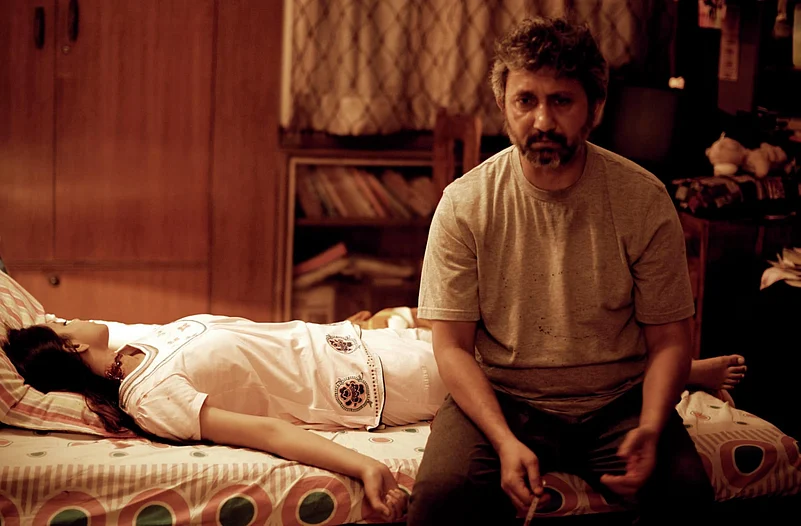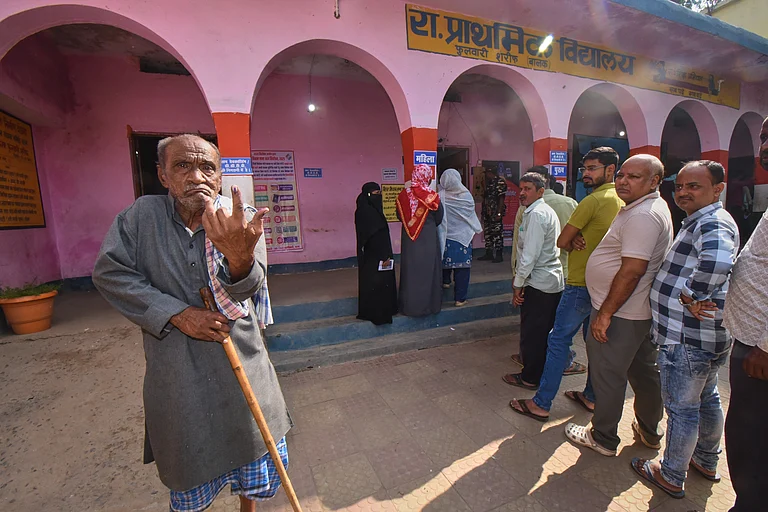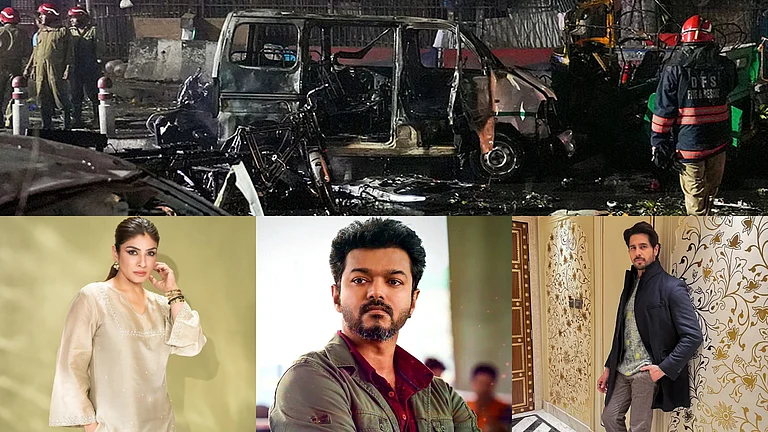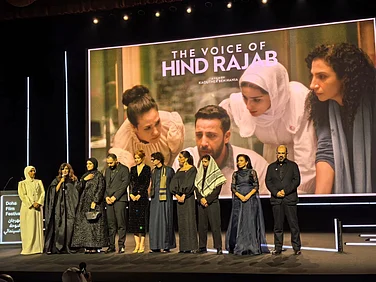
Talvar (2015), directed by Meghna Gulzar and written by Vishal Bharadwaj, celebrates its 10th anniversary on October 2nd, 2025.
The film features Irrfan Khan, Konkona Sen Sharma, Neeraj Kabi, and Sohum Shah at the forefront.
The film is a razor-sharp, unsettling exploration of truth, bias, and the opacity of justice that refuses to offer easy answers.
When Talvar (2015) released, it didn’t roar into theatres with the bravado of a scandalous crime thriller. The 2008 Noida double murder case had already been buried under the weight of speculation, gossip, and premature verdicts. Everyone was an expert, everyone had an opinion, and empathy was quite sparse. By the time Meghna Gulzar’s film premiered, the story had already been stolen a hundred times over, drifting into the fever dream of collective judgement. In the public imagination, Aarushi was never allowed to remain a child, but reduced to caricature: a teenager at the centre of adult hysteria.
She became a cautionary tale, a symbol of everything that frightened middle-class morality and a private life misunderstood through a patriarchal lens. Whispers of impropriety, rumours of a “compromising position”—the gossip was endless, cruel, and deeply revealing. It showed how women’s lives are consumed by public imagination and how, even in death, they remain subjects of scrutiny rather than empathy. The “talvar,” or sword, apart from being a nod to the tragedy, became an instrument and indictment, signalling justice and its ultimate collapse. It still hangs over the story sharp and unresolved.
At its core, Talvar is truly about storytelling itself—who tells it, who owns it, and who suffers when the supposed pursuit of truth becomes an entire nation’s dinnertime ritual. Into this circus walked Talvar, which questioned bureaucracy and bias within the system and dramatised the autopsy of a nation addicted to answers, even when the authorities had none to give. The case was tailor-made for the nation’s moral theatre—an upper-middle-class girl, a domestic worker, and just enough talk of “honour” and “shame” to keep regressive audiences righteously entertained. By the time the film arrived, some viewers accused it of siding with the parents, but that’s exactly what Talvar punctured—the idea that every tragedy must pick a team.

A decade later, Talvar feels almost clairvoyant. As true crime shows now top trends and every tragedy comes prepackaged for streaming, Talvar serves as a reminder that art can be responsible even when reality isn’t. It redefined what “true crime” could mean: not voyeurism, but a moral inquiry. The film turns the viewer from voyeur into witness, asking us to examine our appetite for scandal and our complicity in cruelty. In the past few years, India has become a content goldmine for true crime storytelling—podcasts, docuseries, and viral YouTube explainers, all claiming to offer “exclusive access” to collective trauma.
From House of Secrets: The Burari Deaths (2021) to Dahaad (2023), real tragedies have been repackaged into weekend binges, each more consumable than the last. Even now, few Indian films about real crime walk that tightrope of empathy and ethics with such unflinching grace. There’s a fragile boundary between investigation and exploitation, and Indian cinema repeatedly trespasses. The Kashmir Files (2022) and The Kerala Story (2023) turned “truth” into blunt instruments of ideology, where facts became flexible props in the theatre of morality. Released in the same decade as No One Killed Jessica (2011) and Raman Raghav 2.0 (2016), Talvar refused both the thrill of outrage and the seduction of style and made its consequences feel unbearably human.

Where Kurosawa’s Rashomon (1950) interrogated individual perception, Talvar magnified this inquiry to collective consciousness. In India, truth is always a social construct, filtered through caste hierarchies, class anxieties, and the moral panics of the public gaze. The narrative is built around three conflicting investigations by various State agencies, each claiming to hold the truth. The genius lies in how the film lets contradictions breathe as the audience confronts their own prejudices in real time. That’s also the paradox of Talvar: a film about uncertainty that feels certain in its ethics. It doesn’t absolve anyone, yet it humanises everyone. Even Irrfan Khan’s CBI officer, brimming with sharpness and frustration, isn’t a hero, so much as a mirror of the system’s decay. His cynicism becomes our own. The film’s climax—three versions of the same event played side by side—summarises the futility of seeking closure in a world built on bias.
As Nutan Tandon (Konkona Sen Sharma) and Ramesh Tandon (Neeraj Kabi) emphasise occasionally not even being offered the time and space to grieve, it is exactly here, where Talvar found its purpose. It did not attempt to rewrite the story—it interrogated why we wanted one in the first place. The film’s quiet rage lies in how it exposes our collective failure to protect the vulnerable at multiple levels. Talvar does something revolutionary in response—it restores Aarushi’s humanity. The film never sensationalises her and she isn’t defined by her death or reduced to a headline. Her absence haunts every frame and Gulzar handles her story with extraordinary restraint. Aarushi, in this retelling, becomes the face of countless Indian girls who are first disbelieved, then defamed, and finally forgotten.
Because let’s be honest—why do we consume true crime the way we do? Is it justice we crave, or drama? Maybe it’s easier to feel outrage than grief. We can moralise safely from our couches, applaud justice as performance, and scroll past the next tragedy. Months before Talvar, another film, Rahasya (2015), had loosely adapted the same case. It was efficient but hollow—a mystery eager to entertain rather than empathise. Talvar, in contrast, transformed the same material into an act of mourning and understood that sometimes, ambiguity tells the most painful truths.

A decade later, it stands as one of the most ethically grounded films in modern Hindi cinema. It changed how filmmakers approach true events, proving that restraint can be cinematic, and empathy can be revolutionary. The music in Talvar, with songs like “Insaaf” and “Zinda” underscore dignity in the place of sentimentality. Talvar also opened doors for women directors in crime narratives, challenging a space historically defined by masculine bravado. Meghna Gulzar brought something subversive—a feminine gaze in a genre addicted to violence. However, the film’s greatest success lies, perhaps, in what it refuses to give us: closure. The case remains unresolved in public consciousness, yet Talvar finds meaning in that discomfort.
Rewatching Talvar in 2025 feels almost prophetic. In a digital era where outrage circulates faster than facts, the film’s restraint feels rebellious. What remains remarkable is how the film never exploits grief. It allows emotion to exist without performance. It even extends compassion to those within the machinery—the police, the lawyers, the bureaucrats—people corrupted less by malice than by monotony. The film understands that systems fail not only because they are unjust, but because they are tired. In that exhaustion, Gulzar locates tragedy. Talvar predicted this fatigue long back. It warned us that once truth becomes consumable, it stops being transformative.
Even ten years later, Aarushi’s story is no longer about guilt or innocence—it’s about how a nation processes grief. Talvar reminds us that art, at its best, can restore dignity where the world has stolen it. Behind every case, there is still a child, a parent, a nation learning how to mourn without performance. Maybe that’s why Talvar endures. It doesn’t offer catharsis, but conscience. It reminds us that uncertainty can be its own form of truth, and silence, when chosen wisely, can be justice. Rewatching Talvar is to face a mirror showing how little has changed. Scandal now spreads faster, fed by algorithms turning tragedy into viral content. Talvar’s relevance endures, revealing our complicity in prioritising sensation over patience, judgement over truth, and asking if we have truly learned anything at all.



























